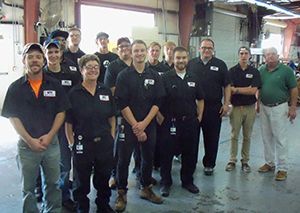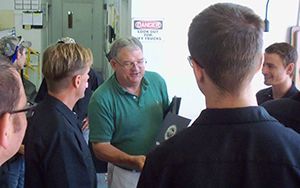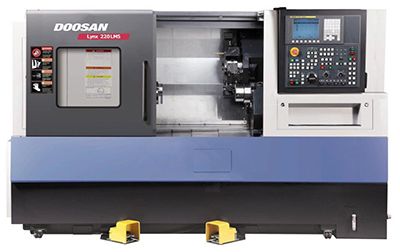Weber Manufacturing Blog
Weber Manufacturing is proud to announce that we have achieved ISO 9001:2015 Certification well ahead of the September 2018 deadline.
This certification provides tangible evidence of our commitment to continuous improvement.
Each one of our team members has been thoroughly trained in our quality assurance procedures and we all share the same commitment to providing our valued customers with the highest quality products and exceptional customer service.
ISO Standards are revised every 5 years to ensure that they are useful and relevant in the current marketplace. This new version places greater emphasis on effective supply chain management and leadership engagement.
 For the second year in a row, Weber Manufacturing has had the pleasure of hosting the students of the Precision Machining & CNC Automation program at the Suncoast Technical College (STC), formerly SCTI, and their instructor, Ed Doherty.
For the second year in a row, Weber Manufacturing has had the pleasure of hosting the students of the Precision Machining & CNC Automation program at the Suncoast Technical College (STC), formerly SCTI, and their instructor, Ed Doherty.
During their visit this past October 31, students got to experience all of the precision machining processes that Weber Manufacturing uses and they had the opportunity to ask questions of people who are already gainfully employed and proficient at the skills that these students are just beginning to learn.
For many Americans, the word "manufacturing" conjures up images of a dangerous workplace and low wages, but the reality is that modern manufacturing facilities are cleaner than many doctor's offices and staffed by highly-skilled professionals who are very much in-demand.
"We want everyone considering a traditional 4-year degree to know that a career in manufacturing will get them on track to financial independence with far less student loan debt and far more opportunity than they ever imagined" said Weber Manufacturing President, Sam Prost " and we hope these soon-to-be graduates will remember us when they are ready to enter the  workforce."
workforce."
 According to the U.S. Department of Commerce, for the past decade, new hires in manufacturing have earned an average of 38% more than new hires in non-manufacturing industries and, over their careers, manufacturing workers earned 17% more in wages and benefits than their counterparts in other sectors.
According to the U.S. Department of Commerce, for the past decade, new hires in manufacturing have earned an average of 38% more than new hires in non-manufacturing industries and, over their careers, manufacturing workers earned 17% more in wages and benefits than their counterparts in other sectors.
The Precision Machining & CNC Automation program at STC teaches students how to set up and operate manual and Computerized Numerical Control (CNC) machines with the latest equipment.
Students learn how to program CNC machines and how to use precision measuring instruments and CAD/CAM (Computer Aided Design/Computer-Aided Manufacturing) processes. The 1,200 hour education includes extensive laboratory activities and real-world experiences like the one at Weber Manufacturing.
For more information about Weber Manufacturing and Supplies, contact Sam Prost at (941) 488-5185
Weber Manufacturing Announces the Addition of the Doosan Lynx 220LMSA to their Lineup
The addition of this high performance mill-drill turning center brings new capabilities to one of the area's leading precision machined products manufacturers.
NOKOMIS, Florida (September 17, 2014) – Driven by the demand for larger part sizes and the desire to upgrade their Computer Numerical Control (CNC) equipment, Weber Manufacturing has just announced the addition of the powerful Lynx 220LMSA to their lineup of precision machining equipment.
 This high performance mill-drill turning center with full contouring C-axis sub spindle and live tooling can complete operations like milling, drilling, and tapping without having to switch to another machine, and its large bar capacity means that we can now perform all of these operations on parts of up to 2" in diameter.
This high performance mill-drill turning center with full contouring C-axis sub spindle and live tooling can complete operations like milling, drilling, and tapping without having to switch to another machine, and its large bar capacity means that we can now perform all of these operations on parts of up to 2" in diameter.
"The ability to complete more operations on a single machine eliminates the cost of an additional set up and it improves delivery times for our customers, while improving our already high quality – it's a win-win!" said Weber Manufacturing President, Sam Prost. "In our lineup of over 40 machines, we have a couple that can perform multiple operations, but none on parts of this size or at this incredibly high speed."
With its ultra-rigid construction and advanced technological features, the Lynx 220LMSA is designed to offer high accuracy and superior surface finishes for years to come, and its high speed turret indexing and fast rapid traverse rates minimize non-cutting time for exceptional value.
For more information about Weber Manufacturing and Supplies, or the state-of-the-art Doosan Lynx 220LMSA, contact Sam Prost at (941) 488-5185.
About Weber Manufacturing and Supplies
Weber Manufacturing and Supplies, Inc. (www.webermfg.com) has been providing a complete range of precision machining services, including CNC Turning, Grinding, CNC Milling, and Thread Rolling, as well as a complete array of secondary operations, since they opened their doors in 1963.
If you think that just multiplying the part length by the number of parts needed is the answer you will be quite disappointed...
The number of these needed is more than just the number of parts times the part length in inches...
The usually accounts for the vast majority of stock required.
But the amount of material lost by cutoff tooling(kerf loss), the first piece and remnant in the machine "steal" parts makeable from the material you purchase.
Parts can also be lost from production by failure to conform to requirements for dimension or during an extended campaign to get the set-up dialed- in.
Guest post by Steve Staub, Made In Dayton Blog
I was contacted recently by a potential customer asking for our hourly shop rate. When I asked him why, he said it was so that he could compare our services against that of our competitors. I told him that our hourly rate doesn't really matter when looking at the overall cost of manufacturing a part and choosing the right supplier.
He did not understand what I was talking about so I went on to explain it like this. Let's say that Company X has a new state of the art Whatzit machine and Company Z has a 10 year old Whatzit machine. Company X charges $ 100.00 per hour on their machine, Company Z charges $50.00 per hour on the machine that they have. Which company are you going to choose?
I'm guessing that you have decided to go with Company Z because they charge only $50.00 per hour. But, did you know that with technology improvements a new Whatzit machine is actually 50% faster than they were just 10 years ago? This actually makes the price the same between the two companies... or at least close.
But what if the pricing wasn't the same? Let's say that two companies quoted production of a part and Company A came in around 10% cheaper than Company B. Do you automatically give the project to Company A? If you do, you're certainly not alone. Many companies do this all the time and the lowest price always wins. But is it really a lower price if you have a lot of rework? Is it truly a better price if the project is late? Here are some questions I like to ask to really find the lowest overall cost:
- Does this company have a track record of on-time delivery?
- How is their quality and what is their rejection rate?
- Can they track my material and offer material certification?
- How easy are they to deal with?
- Will a real human answer the phone?
- Are they convenient to get to or are they located in the middle of nowhere?
- Are they ISO certified and do they have a Continuous Improvement plan?
- Are they the newest kid on the block or are they an established, stable company with an Outside Board of Advisors?
All of these questions (and likely more) need to be answered to make sure that you are dealing with a reliable and reputable company that is going to provide you with a good value and be around to service you for years to come. I'm not saying this is the only way to evaluate a supplier. I'm just sharing some things to think about.
The reason everyone wants to describe our current unemployment situation as cyclical just might be because 'cyclical unemployment' is cause agnostic. Cyclical unemployment is defined as just "the deviation of unemployment from its natural rate."
Since it is just a variation, we need not look too hard for causes, it will go away.
Sandra Pianalta, Chairman of the Cleveland Fed, and a member of the FOMC, is on record as saying that unemployment is cyclical:
Pianalto: I still believe that our current high unemployment is a cyclical problem and not a structural one. There's been a longstanding relationship between the amount of growth in the economy and the improvement that it translates into in terms of job creation. We've had a very weak recovery that hasn't created a lot of jobs. So the slow pace of this recovery is causing that unemployment rate to move down more slowly than we'd like.
I'm reassured that this issue is cyclical and not structural when I look at job openings. Prior to the recession, there were two individuals looking for every job that was open, so it was a 2-for-1 ratio. During this recession, that number has jumped to four people looking for every one job opening. So we just have a very slow pace of job openings, which, again, is cyclical, in my thinking.
"Convincing millions of Americans they don't want a job or compelling desperate workers to settle for part time work has been the Obama Administration's most effective jobs program." – Peter Morici
Adding to the deficit to pay for it is yet another issue.
The economy added 146,000 jobs in November, up a bit from 138, 000 in October. The Dept. of Labor reported that Unemployment fell to 7.7 percent, largely because 542,000 additional adults chose not to look for work.
In the weakest recovery since the Great Depression, most of the reduction in unemployment from its 10.0 percent peak in October 2009 has been accomplished through a significant drop in the percentage of adults working or looking for work.
Were adult labor-force participation the same today, the unemployment rate would be 9.7 percent.
